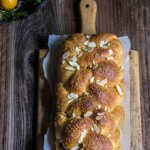
Bulgarian Easter bread {kozunak}
Bulgarian Easter bread - kozunak is a cotton-soft, sugar-crusted sweet bread, studded with rum-soaked raisins, and perfumed with vanilla and lemon zest - the ultimate Easter breakfast.
Ingredients
- 250 ml milk
- 1 cup granulated white sugar
- 200 ml grapeseed / sunflower, or avocado oil (choose a light, neutral-tasting oil)
- 4 eggs
- 2 lbs white flour
- 2 tsp vanilla extract
- 1/2 tsp salt
- zest of 2 lemons
- 14 g instant yeast
- 150 g raisins, soaked in rum
- chopped almonds, for sprinkling on top
- 1/2 cup coarse (Demerara) sugar, for sprinkling on top *
- 1 egg white, for brushing the top
- rum or brandy for soaking the raisins
Instructions
-
Sift the flour into a big bowl. Take out 1-2 cups, and reserve for later.
-
Add the sugar to the milk, and heat on the stove until the sugar dissolves. Let cool, until quite warm, but not hot. Add half of the oil (100 ml), the yeast, vanilla, lemon zest and salt. Mix well (no need to wait for the yeast to proof first).
-
Make a well in the flour, and pour in the milk-yeast mixture. Add the eggs, and start mixing by hand. The dough will be pretty sticky and shaggy at first. Remove the dough to a well floured surface, and continue to knead for at least 5 minutes, by adding some of the reserved flour, until the dough is no longer sticky, and forms a nice, elastic, medium-soft ball. (Up until this point, you can do this in a KitchenAid mixer, but for the next step, use your hands).
-
Make a dent in the dough, and add some of the reserved oil. Knead by pulling and stretching over and over, until the oil is absorbed. Continue to add the rest of the oil, little by little, until all of it is fully incorporated (I did this in 5-6 intervals). At this point the dough will not be sticky, and there is no need to add more flour. This step will take another 10-15 minutes.
-
Weigh the dough, and divide into two equal portions (if making two loaves), or leave in one whole piece. Place in a lightly oiled bowl, cover tightly with plastic foil, wrap a warm towel around it, and leave in a warm place to proof. The dough should triple in volume during the first proofing. It may take 2-4 hours, or more, depending on how warm your kitchen is. (It took mine 4 hours). **
-
While the dough is proofing, place the raisins in a shallow bowl, and pour enough rum over them to cover them completely. Let soak for at least 30 minutes. Drain well. ***
-
Once the dough has tripled in volume, divide each loaf into 3,4 or 6 equal portions, depending on what braid design you'd like to make. The easiest, and the most traditional is a 3-strand braid. So if making two loaves, that means, divide the dough into 6 equal portions (about 300 g each). Take one portion, and cover the rest with plastic wrap, while you are working on it.
-
Oil your hands, and using a clean flat surface, gently stretch the piece into an oblong shape, about 3-4 mm thick, by tapping lightly with your fingers. Do not use a rolling pin! Spread about 1 Tbs of raisins over it, and roll out to seal the filling. Take both ends of the strand, and twist in opposite directions, so you end up with a twisted rope. Lightly oil the rope, and proceed with the rest of the portions.
-
Braid the ropes into the desired type of braid. Check out this tutorial if you want to make a round-shapeed 4-strand braid, or this one for a 6-strand long braid.
-
Line your baking pan/form with parchment paper, and place the braided loaf in it. Cover tightly with plastic wrap, and a warm towel and leave in a warm place to proof a second time. This time, your dough is done when it roughly doubles in volume.
-
Preheat your oven to 325 °F.
-
Beat the egg white lightly, and brush all over the bread surface.
-
Sprinkle the loaves liberally with the coarse sugar, and chopped almonds.
-
Bake for 40-50 minutes. Monitor the bread, and around 15-20 minutes into baking, cover the top with aluminum foil to prevent the crust from burning. If making two loaves, check if your bread is done after 40 minutes by inserting a long wooden stick. If you are making one big loaf, check for doneness in 50 minutes. It's important to not overbake the bread, so it doesn't lose its moisture.
-
Let it cool off a bit, uncovered to preserve the sugary crust crunchy, and serve on its own with a glass of milk!
Recipe Notes
* You can find Demerara sugar online.
** Turn your oven on the lowest setting - 100 °F, and once it reaches this temperature, turn if off, and put your loaf in the warmed up oven to proof.
*** Other filling ideas to try:
- Fruit preserves + chopped nuts (use jam sparingly - too much filling will prevent the dough from rising properly the second time)
- Turkish delight, chopped into small pieces + walnuts.
- Mix equal parts cacao powder and brown sugar, and spread evenly over the stretched dough, or use Nutella/chocolate chips.
Calories are calculated assuming each loaf is 8 portions.